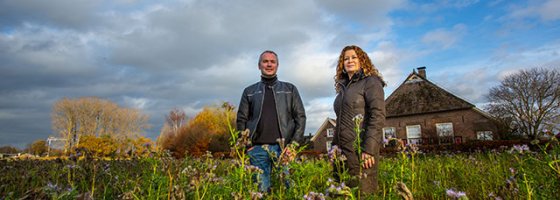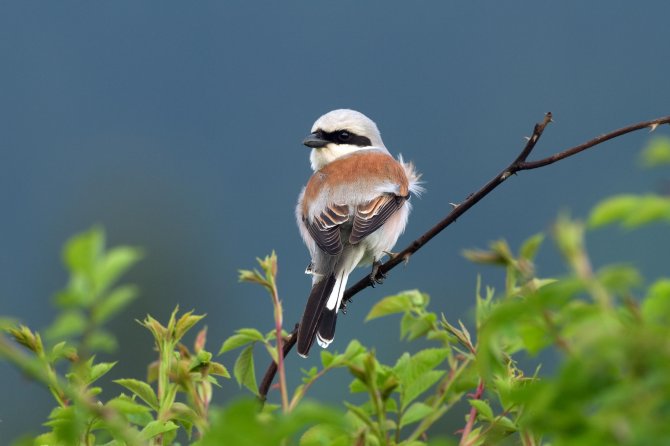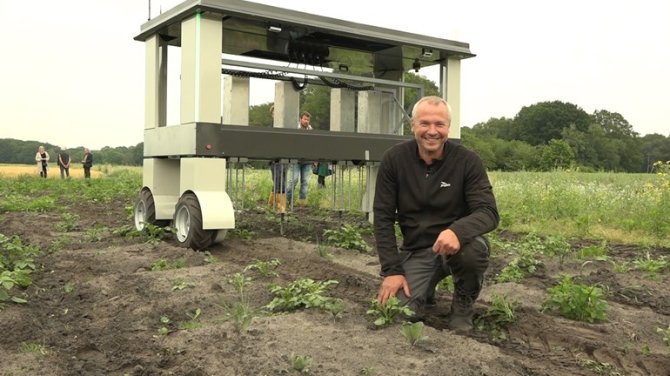Blog post
The Velhorst estate: prince charming of agricultural practices
What is more nature-based: one monoculture or a biodiverse patchwork of crops? Farmers Arjen and Winny van Buuren know the answer. On the Velhorst estate in Lochem they apply intercropping. This way, they combat vulnerability to climate change, loss of biodiversity and a monotonous landscape. Wageningen University & Research collects data to underpin the effectiveness of this initiative. For this blog, we interviewed Arjen van Buuren about this hands-on example of nature-based solutions for climate resilient and circular food systems.

Farmers Arjen and Winny van Buuren
Biodiversity
The biodiversity decline cannot go on any longer
At first hand, Arjen observed that less meadow birds and insects visited agricultural monocultures. This observation made him realise that a change in business operations was necessary. How to use arable land in a sustainable way? He went for mixed cultivation. On the Velhorst estate you can find an eye-catching agricultural area in which 30 crops are spread over several pixels and strips. Insects, birds and soil life have been monitored. Last year, four field bird species have been spotted that were not present before. They all hatched and give life to their young.

Pest control
When a monoculture is replaced by a more biodiverse system, diseases and pests can spread less quickly and there are more natural enemies nearby. Strips and pixels all have different crops. This creates more crop biodiversity and attracts more natural enemies. The entire system becomes more resilient with minimal intervention. On the Velhorst estate Wageningen University & Research tries to find out why certain crops thrive side by side. What makes certain crop combinations effective in disease and pest control? Since the Velhorst estate is rather large, there is many data to obtain. A real feast for scientists!

Innovation
All innovations require time and money.
Mixed cultures are more labour intensive to handle. On the Velhorst estate crops are harvested six days a week, but not all by the farmer. Pixels are leased to individuals for €10,- per season, including seeds or planting material of the crops that have been chosen by the individual. Tenants can harvest the crops themselves within fixed timeframes. Harvest from non-leased pixels are sold to individual clients in the farm shop, to supermarkets and to restaurants. For the non-leased pixels they do had to plant the crops manually last year. GPS-driven robots are not sophisticated enough to saw neat rows or pixels yet. But Arjen is not worried about it. All innovations require time and money and the robot seems to be promising. Someday, a robot will sow, plant, weed and harvest autonomously. Arjen will sit less on his tractor seat and can spend more time in the field. Additionally, his substantial diesel bill will belong to the past, since the robot will use solar energy.

Circularity and short chains
Soil is our most important asset.
Cows and sheep in the fields supply nutrients to the soil. They regularly plant legumes that fixate nitrogen, improve the structure of the soil and supply organic matter. All in all, little extra manure is needed for the crops to grow. Soil is highly important to Arjen. A healthy soil is the basis for their final products such as flour bread, beer, rapeseed oil, quinoa and meet that they market themselves, without middlemen.
Showcase
Sharing knowledge gives energy.
Whenever Corona-measures allow for it, tours are organised on the Velhorst estate to show what it looks like in practice to do things differently. Arjen gives tours to customers, companies, politics, schools and others. Furthermore, he is lecturer and project leader at Agro Innovation Centre De Marke. Most of the students are very familiar with monocultures, not with mixed cultures. By inviting them to the farm, students are stimulated to discuss future farming. He noticed that sharing knowledge gives energy.
On the Velhorst estate, everything has been carefully thought through to make it as beautiful as possible. Great things happen with collaborations between many partners who are equally enthusiastic. Arjen invites you as well to come and see with your own eyes how Velhorst exemplifies nature-based solutions for climate resilient and circular food systems.
- Unfortunately, your cookie settings do not allow videos to be displayed. - check your settings
More information
Zenderse Es Borne is a second agro ecological farm in Borne where the goals and mission are the same as at Velhorst.